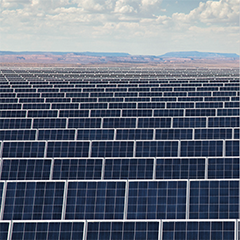Ron Corio is the founder of Array Technologies, pioneers of solar tracking technology. Array Technologies built its first tracker for bifacial modules in 2009 and has been studying bifacial modules coupled with utility scale trackers at a test-site for the last year, and recently launched a new partnership with a national laboratory in New Mexico. At Intersolar North America 2018, Array explained that it will continue to push its study of the convergence of bifacial and tracking technologies; namely how these studies will help to better identify and interpret the multitude of factors which go into predicting the energy output of future plants combining these two technologies.
Innovation has driven the growth and development of the PV industry. With that innovation has come increased reliability, bankability, optimized energy yields, and higher efficiencies – making solar more and more appealing to stakeholders.
One of the most promising innovations is the emergence of bifacial PV cell and module technology. By producing electricity from both the front and backside of a solar module, PV project owners and developers can profit from increased energy yields from the diffused light hitting the backside of the module.
When coupled with an optimized and reliable PV tracking system, bifacial modules could represent a particularly powerful solution, however, the application of bifacial with tracking is only at its early stages, and a number of challenges remain for large-scale adoption to occur. With the backside yield only a second-order effect, the front side production remains the dominant factor determining total yield. Avoiding the pitfalls which disproportionately drive up cost in order to optimize backside performance is paramount: ‘Cutting off your nose to spite your face,’ so to speak. Optimizing the financial return for bifacial is key.
The nature of bifacial solar modules means that the output of the backside is highly dependent on a number of natural as well as mechanical factors. Specifically, the amount of light that reaches the backside of the module depends greatly on the albedo, or reflectivity of the ground substrate on which the cell is installed. The power gain percentage versus albedo of common installation substrates can range from 5.67% for grass, up to 24.60% for white painted surfaces.1 This large disparity in albedo means that it is impossible to generalize the potential gains from a PV system deploying bifacial technology – making the bankability site specific.
Taking a proactive approach to bifacial with tracking PV applications, Array Technologies has been gathering data from a test array at a Nevada test site for over 12 months. Bifacial modules from a leading producer have been paired with our DuraTrack V3 tracker architecture at the site.
Preliminary findings from a yearlong study revealed that a 9.15% power output gain can be achieved in a bifacial with tracker array when compared to monofacial modules in the same configuration. Although the field data to date shows that two-module-in-portrait (2MIP) orientation delivers the best total power output, the added cost of taller foundations and installation of 2MIP suggest that this maximum power output configuration may not provide the maximum financial return in the aggregate.



























